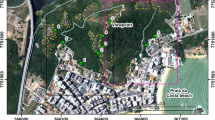Abstract
Disasters caused by events such as earthquake, flooding, rock falls, landslides are often encountered. However, generally, the reasons for the destructive and devastating effects of these nature events are that settlement locations were chosen without site investigation studies, or that available studies were inadequate. Such inadequacies in the field are related to inappropriate settlement location and the resulting damage caused by rock falls. This study evaluated rockfall risk in a settlement that developed in a similar manner. The study was carried out in Boğaziçi village of Kemah (Erzincan/Turkey), which is located in a very important tectonic zone. The study site is located on the lower sections of an area with very steep cliffs and 50–75° slopes. This cliff, which is the source of rockfalls, has a slope dip of approximately 90°. The cliff comprises 25–30 m high, fractured and cracked basaltic volcanic mass. To determine block size in the study area, scanline survey measurements and block size measurements were performed on blocks that loosened and fell from the cliff face. It was found that block sizes reached 6 m3. Rockfall analyses were performed along the selected profiles using the Rockfall V.4.0 software. Kinetic energy, bounce height, horizontal location of rock end-points, and velocity of the rocks along each section were evaluated separately for each profile. This data were used to produce distribution maps for each profile and the settlement was evaluated in terms of rockfall risk. The results indicate that the study area was at risk of future rockfalls and that it would be appropriate to relocate one part of the settlement.













Similar content being viewed by others
References
ArcGIS (V. 9.1) (2005). Integrated geographical information system software, ESRI, CA
Binal A, Ercanoğlu M (2010) Assessment of rockfall potential in the Kula (Manisa, Turkey) Geopark Region. Environ Earth Sci 61:1361–1373
Bull WB, King J, Kong FC, Moutoux T, Phillips WM (1994) Lichen dating of coseismic landslide hazards in alpine mountains. Geomorphology 10(1):253–264
Chen H, Chen RH, Huang TH (1994) An aplication of an analytical model to a slope subject to rockfalls. Bull Assoc Eng Geol 31(4):447–458
Dorren LKA (2003) A review of rockfall mechanics and modelling approaches. Prog Phys Geogr 27(1):69–87
Evans SG, Hungr O (1993) The assessment of rockfall hazard at the base of talus slopes. Can Geotech J 30:620–636
GDDA (2006) Geological data integration planning handbook, the General Directorate of Disaster Affairs, p 199
Giani GP (1992) Rock slope stability analysis. A. A. Balkema, Rotterdam 361
Hutchinson JN (1988) General report: morphological and geotechnical parameters of landslides in relation to geology and hydrogeology. In: Proceedings of the 5th international symposium on landslides, Balkema, Rotterdam, pp 3–35
ISRM (2007) The complete ISRM suggested methods for rock characterization, testting and monitoring: 1974–2006. Suggested methods prepared by the commission on testing methods, ISRM. In: Ulusay R, Hudson JA (eds) Compilations arranged by the ISRM, Turkısh National Group Ankara, Kozan ofset, Turkey, p 628
Kobayashi Y, Harp EL, Kagawa T (1990) Simulation of rockfalls triggered by earthquakes. Rock Mech Rock Eng 23:1–20
Kremier A, Arnould M (2000) World Bank’s role in reducing impacts of disasters. Nat Hazards Rev 1(1):37–42
Marzorati S, Luzi L, Amicis MD (2002) Rock falls Induced by earthquakes: a statistical approach. Soil Dyn Earthq Eng 22:565–577
NEMC (2012) B.U. Kandıllı Observatory and Earthquake Research Instıtute, Natıonal Earthquake Monıtorıng Centre, http://www.koeri.boun.edu.tr/sismo
Priest SD (1993) Discontinuity analysis for rock engineering. Chapman&Hall, London
Ritchie AM (1963) Evaluation of rock fall and its control. In: Highway research record 17, HRB, National Research Council, Washington, DC, pp 13–28
Rocscience (2002) RocFall software—for risk analysis of falling rocks on steep slopes. Rocscience user’s guide, p 59
Schweigl J, Ferretti C, Nössing L (2003) Geotechnical characterization and rockfall simulation of a slope: a practical case study from South Tyrol (Italy). Eng Geol 67:281–296
Tunusluoğlu MC, Zorlu K (2009) Rockfall hazard assessment in a cultural and natural heritage (Ortahisar Castle, Cappadocia, Turkey). Environ Geol 56(5):963–972
Varnes DJ (1978) Slopemovement types and processes. In: Schuster RL, Krizek RJ (eds) Landslides, analysis and control. Transportation Research Board, Special report no. 176, National Academy of Sciences, pp 11–33
Vidrih R, Ribicvicv M, Suhadolc P (2001) Seismogeological effects on rocks during the 12 April 1998 upper Socva Territory earthquake (NW Slovenia). Tectonophysics 330(3):153–175
Yılmaz I, Yıldırım M, Keskin I (2008) Amethod for mapping the spatial distribution of RockFall computer program analyses results using ArcGIS software. Bull Eng Geol Environ 67:547–554
Zellmer JT (1987) The unexpected rockfall hazard. Bull Assoc Eng Geol 24(2):281–283
Acknowledgments
The author is also very grateful for the significant and constructive comments of the anonymous reviewers.
Author information
Authors and Affiliations
Corresponding author
Rights and permissions
About this article
Cite this article
Keskin, İ. Evaluation of rock falls in an urban area: the case of Boğaziçi (Erzincan/Turkey). Environ Earth Sci 70, 1619–1628 (2013). https://doi.org/10.1007/s12665-013-2247-9
Received:
Accepted:
Published:
Issue Date:
DOI: https://doi.org/10.1007/s12665-013-2247-9




